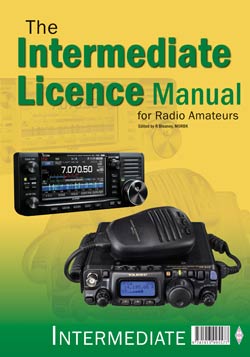
The Next Step: The Intermediate Licence
Now that you have your amateur radio licence and have gained experience operating, it may be time for you to move on to the Intermediate licence.
The Intermediate licence carries with it more privileges and also more responsibilities on you as a radio amateur.
Studying for your Intermediate Exam
Understandably the Intermediate course is longer and more challenging than the Foundation, but builds on the experience you have gained as a Foundation licence holder.
The table below contains links to printable versions of our course notes, for an embedded scrollable version of these documents use the menu at the top of the page “Training” – “Intermediate” – “Topic”
| Topic Number | Printable Notes | Presentation Slides | Videos |
|---|---|---|---|
| Introduction | |||
| 1 | Licensing Conditions and Station Identification | Licensing Conditions and Station Identification | |
| 2 | Technical Aspects | Part 1: Fundamental Theory and Resistance Part 2: Reactive Components Part 3: AC Theory Part 4 etc. To Follow |
|
| 3 | Transmitters and Receivers | Part 1: Transmitters Part 2: Receivers Part 3: SDR Transmitters and Receivers |
|
| 4 | Feeders and Antennas | Feeders and Antennas | |
| 5 | Propagation | Propagation | |
| 6 | Electromagnetic Compatibility (EMC) | Electromagnetic Compatibility (EMC) | |
| 7 | Operating Practices and Procedures | Operating Practices and Procedures | |
| 8 | Safety | ||
| 9 | Measurements and Construction | Measurements and Construction | |
| 10 | There is no Topic 10 at the Intermediate Level as, commencing with Syllabus 1.4, there are no longer any Practical Assessments | ||
The Intermediate Exam
The Intermediate examination is similar in format to the Foundation Exam, this time the exam consists of 46 multiple-choice questions each with four possible responses of which only one will be completely correct. You are permitted 90 minutes to answer the questions and the pass mark is 28/46 or 61%.
| Subject | Number of Exam Questions | Percentage of Exam Questions |
|---|---|---|
| Licensing Conditions and Station Identification | 6 | 13.04% |
| Technical Aspects | 14 | 30.44% |
| Transmitters and Receivers | 7 | 15.22% |
| Feeders and Antennas | 4 | 8.70% |
| Propagation | 3 | 6.52% |
| Electromagnetic Compatibility (EMC) | 4 | 8.70% |
| Operating Practices and Procedures | 2 | 4.35% |
| Safety | 3 | 6.52% |
| Measurements and Construction | 3 | 6.52% |
| TOTAL | 46 | 100.01% |
Unlike the Foundation Exam, the main focus of the Intermediate Exam is on the Technical Aspects which accounts for nearly one third of the whole exam. Whilst it is possible to secure a pass without any correct answers in the Technical Aspects section it does require that 28 out of the remaining 32 questions are answered correctly, that’s a daunting 87.50%
What Happens After the Intermediate Exam?
If you have passed the Intermediate exam you will receive an official result sheet confirming the pass from the RSGB.
The next step is to register your Intermediate exam pass with the UK communications regulator Ofcom, who are responsible for issuing amateur radio licences. If you apply for your Intermediate licence on the Ofcom website, your licence is free of charge. Visit the Ofcom website to find out more. Ofcom will then issue you with your new, upgraded radio licence and you can get started immediately on the Intermediate frequency allocations at up to 100 watts power.
Now you are not only a licensed radio amateur, but you are one step closer to having the Full licence; an internationally recognised qualification that will enable you to transmit legally almost anywhere in the world.
